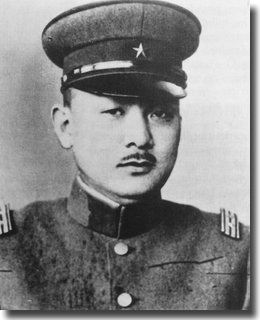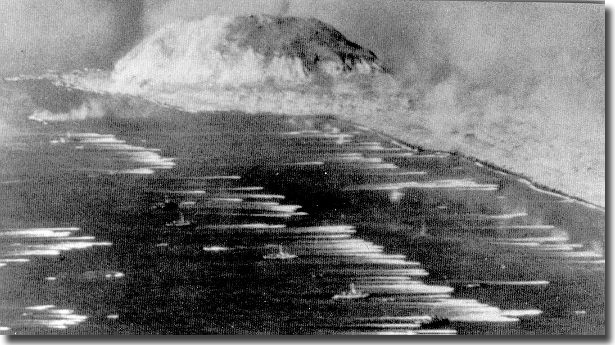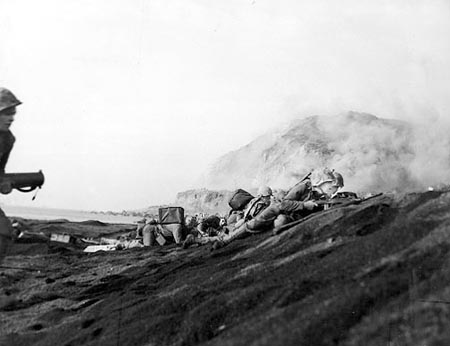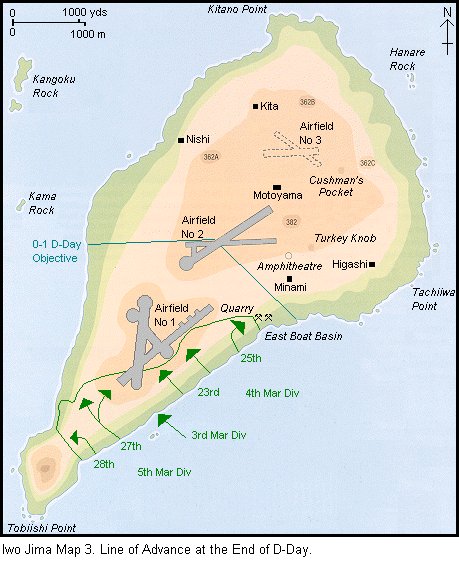The Battle of Sulphur Island, fought for thirty six hellish days in February and March of 1945, was an epic conflict, pitting desperate and hardened foes in a fight to the death.

United States army, naval, and marine forces, over 100,000 strong, hurled themselves upon the small plot of land in the Pacific within which their Japanese enemy awaited them.
For months, Japanese Lieutenant General Tadamichi Kuribayachi and his forces prepared virtually impregnable defenses, linked together through a labyrinthine network of tunnels,stretching sixteen miles long, connecting fifteen hundred underground chambers.

The underground passageways even snaked their way to the heights of the island's volcanic mount, Suribachi, located on the southern tip of the land mass. Incredibly, General Kuribayashi's command post, located at the extreme opposite point of the compass, had five foot thick walls, a ten foot thick roof and was located under seventy five feet ft of solid rock. The general and his fellow warriors, committed to the ancient doctrine of the way of the bushido, intended to fight to the death, vowing to kill ten Americans before dying themselves. If the battle could not be won, the Japanese at least hoped that massive American casualties would delay or deter further advances toward the land of the rising sun.
When American forces landed upon the blackened, sulphuric sand, their initial assault went unchecked; however, as United States Marine, United States Army, and United States Naval forces slogged their way up the lofted terraces of sand, slowed and hindered by equipment and packs, the Japanese opened fire with small arms, machine gun, mortar, and artillery fire, all presighted and enfiladed, to ensure absolute accuracy and massive casualty rates.

Landing forces were literally cut to pieces as the first day wore on; yet, many units and individual soldiers waded through the storm of shot and shell to carry out orders to establish a beachhead and to cut off enemy forces upon and within Suribachi from the rest of the island.

Many of these Japanese soldiers escaped the trap through the subterranean exits to continue the fight as the battles raged northward toward the precious airstrips that would ultimately be used by Allied forces to launch attacks toward the home islands of Japan and land returning crippled bombers that would otherwise have been lost in the vast waters of the azure blue. Since the summer of 1944, the Japanese had been reeling from strikes by the new, long range B-29's upon Japan proper. The United States Army Air Corps, however, had no protective fighters with enough range to escort the big superfortresses, thus many bombers fell prey to Japanese fighter attacks. Iwo Jima, with its three airfields, was ideally located to serve as an escort and recovery station. Military historians estimate that almost 30,000 American Army Air Corp personnel were saved as a result of victory on Iwo Jima.
The battle's fourth day marked an incident that would echo through the halls of American history for all time, a moment so inspiring, that the hearts of millions have been filled to overflowing gratitude and the spiritual life of the nation has been imbued with wonder at the remembrance. American forces were ordered to the summit of Suribachi to plant the stars and stripes upon the heights for all to see. This act would not mark the end of the battle or the subjugation of all enemy forces; that would be delayed for another month as enemy fighters fought savagely through terrain soon to be named Turkey Knob, the Amphitheater, and Cushman's Pocket, to the very cliffs of Kitano Point on the island's opposite, northern end.

While not signaling ultimate victory, the flag raising did signify that the initial mission had been accomplished and heralded the end of the beginning of the loss and the carnage. Tens of thousands of American forces, both onshore and off, noticed the flag as it caught in the breeze, streaming the stars and the stripes to the sky. A great niose of exultation arose and, for a moment, the fighting subsided and hope invaded the horror of war.

Soon after the first flag raising, a larger flag was sent to the top to be planted in place of the small. News photographers captured both raisings with still and motion picture film; however, the most iconic photograph was taken by Joseph Rosenthal, an Associated Press photographer.

Mr. Rosenthal had scaled the five hundred foot height in time for the second flag raising and prepared to position himself for the shot. A fellow photographer warned Rosenthal of the sudden hoisting as five marines and one navy corpman, aware of pockets of enemy resistance still in the area, hurried to complete the task. Rosenthal instinctively raised his camera and snapped a photograph without having sighted the shot through the camera's lens. The film was taken to Guam via ship, developed, and sent to newspapers in the United States to be available for Sunday editions.
Remarkably, the nation and the world saw, and was awed by, the image before it's taker had even had the privilege of seeing it. Ultimately, it would become the most reproduced photograph in history and it's image would be turned to marble and bronze in tribute to the reflection of bravery, courage, and valor it mirrored. One publication noted that Mr. Rosenthal not only captured a great image, but in that moment, upon that nondescript chunk of volcanic soil, captured upon film, for all time, the soul of a nation.

Upon seeing the flag rise on Suribachi, Secretary of the Navy James Forrestal was said to have remarked, "That means a Marine Corp for the next five hundred years." American Fleet Admiral Chester W. Nimitz remarked that during the battle, among the men who fought on Iwo Jima, uncommon valor was a common virtue." And so it was. Of the eighty one Medals of Honor awarded to members of the United States Marine Corp in World War II, twenty seven were earned on Iwo Jima alone.

Iwo Jima Medal of Honor recipients



..


Three of the six flagraisers in the iconic photo, Sgt.Michael Strank, Pfc. Franklin Sousely, and Pfc. Harlon Block, were dead before American forces secured, then left the island. Virtually every one of the 21,000 Japanese defenders were annihilated, including their beloved general, whose body was never found. In thirty six days of fighting, over six thousand Americans were killed and over 30,000 wounded. By comparison, just under 5,000 military personnel have been killed and an estimated 35,000 wounded in the war on radical Islamic terror since September 11, 2001. Virtually the same number of casualties were inflicted on Iwo Jima in just over one month, an enduring testament to the savagery of the conflict and the immensity of the sacrifice offered by American youth.
It is with awe tinged sadness that one contemplates the horrors of war; yet, it is with grateful hearts and tear filled eyes that Americans ponder and remember such precious and great offerings upon the altar of freedom. To forget such acts of devotion unto liberty, is to heap reproach and condemnation upon ourselves as a people. May we, every American, forever remember and appreciate the boys, the men, who fought, died, lived, and prevailed on Sulphur Island.
Every time you see the beautiful stars and stripes catch the breeze of a peaceful, calming wind, reflect upon those who saw it in the violent tempests of war - the men who won for us our peace and secured for us our freedom. In life, and in death, they stand, shrouded in glory, honored forever by a grateful people. In one's mind's eye, one can still see the flag, majestic upon the heights, representing the steel of American mettle, the hope of her horizon, and the power of her soul.





No comments:
Post a Comment